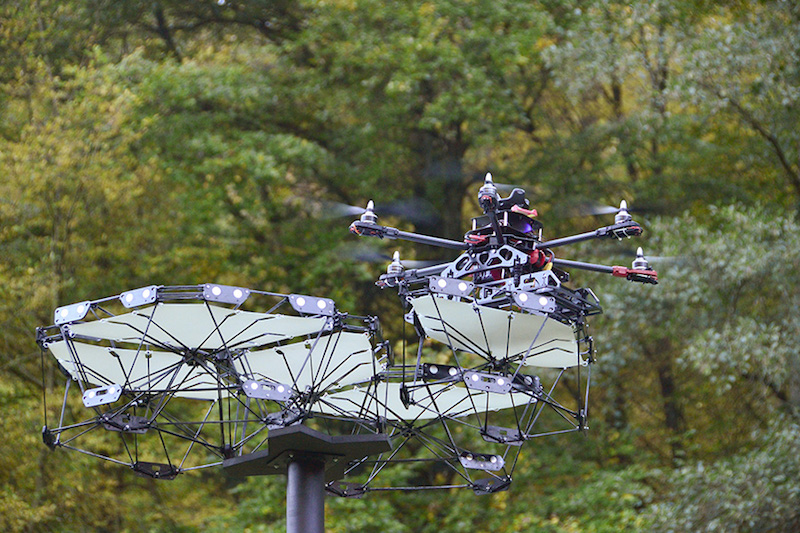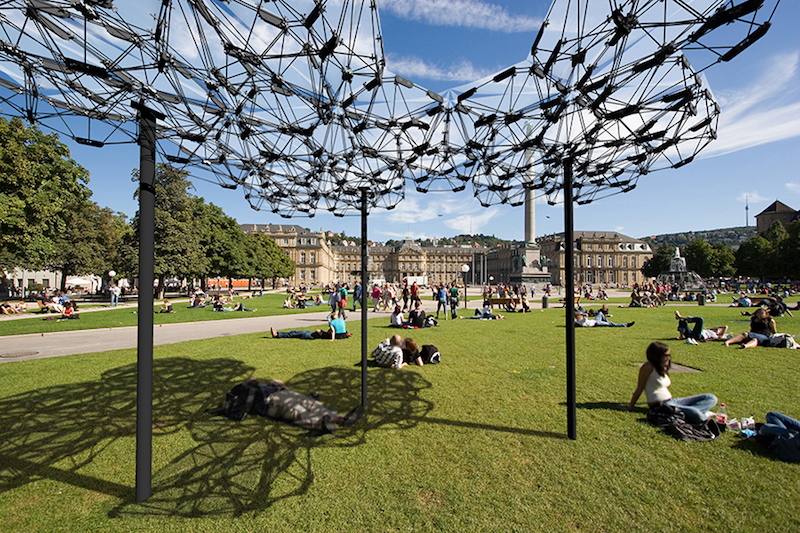Architecture is always evolving. Be it the way buildings are designed, the processes by which they are built, or the materials used. But a new prototype from the University of Stuttgart takes this continuous evolution to a new level, with a reconfigurable canopy system for public spaces that is in a state of perpetual construction.
The Cyber Physical Macro Material as a UAV [re]Configurable Architectural System (hopefully the name will continue to evolve as well) combines cyber-physical building material constructed from lightweight carbon fiber filament with integrated electronics for communication and sensing, with a collection of autonomous aerial vehicles, dubbed builders.

The canopy is composed of individual pieces that measure 40 cm wide, 64 cm long, and 25 cm tall. Each piece is composed of a roof plate that acts as the shading element, an attachment bar for UAV transport, ABS attachment plates with embedded magnets, an electronic board with a microchip, a sensor for external data input, and elements that allow each unit to communicate with every other unit.
See Also: When pigs fly? How about when cows float?
These units communicate with the UAV builders to facilitate the canopy’s movement. Separate vertical zones allow for simultaneous construction and use. This means the builders will be busy overhead changing the structure while users can still enjoy the space beneath. When the builders are not in use, they retreat to a nearby building rooftop.

This combination of distributed robotic construction and programmable matter allows for the canopy system to constantly evolve based on its surroundings. The system can be programmed with responsive behaviors, such as following the sun’s orientation to maintain a constant shadow area, or with interactive behavior, which means the user can place columns as an interface to inform the structure where to grow.
The system can also be set to probe the environment for data to develop and learn new behaviors; after time, the system will be able to predict user behavior and change to a relevant configuration in advance.
It remains to be seen if having a hive of drones buzzing overhead will spoil the experience for some users, or if the builders will be able to reconfigure the canopy quickly enough to keep up with how people would use a given green space. At the very least, the prototype is meant to challenge “preconceived ideas of robotic digital fabrication and sophisticated prefabrication for architecture.” Miguel Aflalo, Jingcheng Chen, and Behrooz Tahanzadeh created the prototype.

Related Stories
Great Solutions | Apr 13, 2020
Family workstations highlight the new Fairfield Area Library
The workstations are the perfect remedy for squirming, restless children and toddlers.
Great Solutions | Feb 5, 2020
Power moves: The Shed
Precise positioning of mechanicals above its lighting keeps New York’s kinetic event space, The Shed, running.
Great Solutions | Dec 18, 2019
Robot uprising
Thyssenkrupp’s robotics interface platform helps robots use elevators like humans.
Great Solutions | Nov 12, 2019
Skanska designs personal protective equipment tailor-made for the female workforce
A safety vest is the first piece of equipment to undergo an update.
Great Solutions | Oct 3, 2019
REEF Technology wants to turn parking facilities into urban mobility hubs
The company currently operates 4,500 parking lots in 25 markets across North America.
Great Solutions | Aug 30, 2019
An ‘Internet of Beings’? Kinetic flooring promises more than just energy generation
Pavegen says its technology delivers a new level of human engagement in sustainability initiatives.
Great Solutions | Aug 7, 2019
Earthquake response system takes the guesswork out of seismic safety
The platform provides real-time monitoring to help avoid unnecessary evacuations and improve emergency response.
Great Solutions | Jul 12, 2019
Smart sensor maintains privacy, enhances safety in sensitive spaces
The HALO IOT sensor is designed for use in places where cameras are not welcome.
Great Solutions | Apr 9, 2019
Raising the roof is cool again
Upbrella allows for floor-by-floor building construction that is, reportedly, safer and more productive than traditional methods.
Great Solutions | Mar 12, 2019
When is wood not really wood?
Inspired by the look and cellular nature of wood, researchers create 3D-printed “digital wood” and “metallic wood” that is as strong as titanium, with the density of water.

















